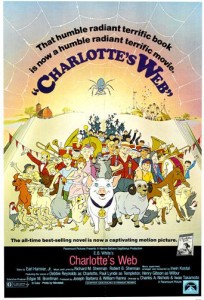 The original movie poster for Charlotte’s Web declared: “That humble radiant terrific book is now a humble radiant terrific movie!”
The original movie poster for Charlotte’s Web declared: “That humble radiant terrific book is now a humble radiant terrific movie!”
Fans still echo this sentiment of the film fifty years later, which is why it continues to be remembered and remains impactful. Coming to audiences from one of the most popular and prolific animation studios of the time, with music from two of film’s best-loved songwriters, Charlotte’s Web continues to be a powerful parable that has connected with so many.
Charlotte’s Web was a popular book by legendary children’s author E.B. White, first published in 1952. It was in 1967 that the book surfaced among film producers, and several different animation directors, such as John and Faith Hubley and Gene Deitch, showed interest in translating it for the screen.
In 1971, the film came to the Hanna-Barbera Studio and would be directed by two veterans of animation and the studio, Iwao Takamoto and Charles A. Nichols. Charlotte’s Web would be the third theatrical feature from Hanna-Barbera, the titans of TV animation, and the first film not to feature one of their famous television stars (Hey There, It’s Yogi Bear and The Man Called Flintstone were the other two).
“Hanna-Barbera had to get personal permission from E.B. White (and his wife) to produce Charlotte’s Web,” says colleague Greg Ehrbar, who has been researching the studio for decades and has also written for its characters. “In his book, Barbera describes a convoluted journey he took to get to the White farm in Maine. He was warmly received, and the Whites were impressed with the art and story material he presented. Hanna-Barbera was given their blessing.”
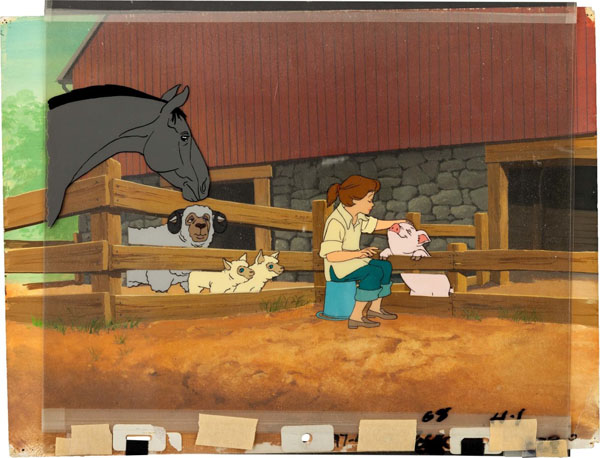
Charlotte’s Web tells the tale of Wilbur the pig, who is saved from the fate of the slaughterhouse by Charlotte, the spider who lives above the pen. Charlotte can weave sayings into her web like “Some Pig,” which amazes the nearby residents, turning Wilbur into a local celebrity.
The film boasts an impressive voice cast that includes comedian Henry Gibson (of TV’s hit Laugh-In) as Wilbur, Debbie Reynolds as the soothing voice of Charlotte, the cackling genius of Paul Lynde as Templeton the rat, Agnes Moorehead as the Goose, child actress Pamelyn Ferdin (who played Lucy in several Peanuts specials) as Fern, the young girl who adopts Wilbur, and cowboy actor Rex Allen as the narrator.
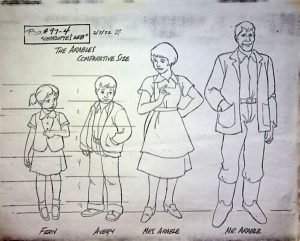 Also in the cast were Hanna-Barbera voice veterans Don Messick as Jeffrey the gosling, John Stephenson as Fern’s father, and Bob Holt as Homer Zuckerman, Fern’s Uncle.
Also in the cast were Hanna-Barbera voice veterans Don Messick as Jeffrey the gosling, John Stephenson as Fern’s father, and Bob Holt as Homer Zuckerman, Fern’s Uncle.
Unlike Hanna-Barbera’s TV series, Charlotte’s Web, even with its talking animals, was grounded with more drama and emotion than the studio had ever produced before, which stems from the story and the character animation, as well. There’s a rich connection between Wilbur and Charlotte that serves as the heart of the film.
Helping to bring such scenes to life was the songwriting team of siblings Robert and Richard Sherman, most famous for their legendary award-winning music produced for Walt Disney on such films as Mary Poppins and The Jungle Book.
Additionally, Irwin Kostal, another Disney mainstay, provided the score.
Reportedly, author E.B. White opposed the use of the Disney style music in the film, but the songs and the score are now remembered as one of the many poignant layers in Charlotte’s Web.
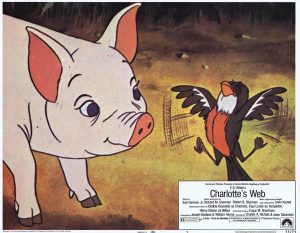 “True, the Sherman Brothers and Irwin Kostal were Disney alumni,” says Greg. “However, few animated features had songs more personal to the composers than Charlotte’s Web. Certainly, E.B. White could not have known the internal emotions that generated the music and lyrics that ended up in the film. Hanna-Barbera welcomed and included them in a manner they had not experienced for a long time after Walt.”
“True, the Sherman Brothers and Irwin Kostal were Disney alumni,” says Greg. “However, few animated features had songs more personal to the composers than Charlotte’s Web. Certainly, E.B. White could not have known the internal emotions that generated the music and lyrics that ended up in the film. Hanna-Barbera welcomed and included them in a manner they had not experienced for a long time after Walt.”
Among the songs for the film was the lovely, lilting ballad “Charlotte’s Web,” the enthusiastic parade march, “Zuckerman’s Famous Pig,” and Templeton’s big number, “A Veritable Smorgasbord,” where the rat sings about the joys of digging through the trash and eating the scraps at the fair, after its closed.
The song is perfect for Lynde, as it fully utilizes his ability to verbalize any word humorously and makes Templeton an audience favorite.
Charlotte’s Web opened at Radio City Music Hall on February 22, 1973, followed by a general release on March 1, 1973. It was praised by many critics, such as Charles Champlin of The Los Angeles Times, who wrote: “No one, I think, could ask for a more respectful treatment of a classic…The grownups will miss some of the artful appeal the book has but can settle gladly enough for a cheerful and enthusiastic piece of children’s fare.”
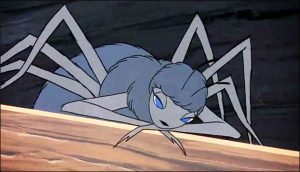 Thanks to not only a successful theatrical run, but also airings on television throughout the 70s and 80s, as well as a release on VHS in 1979, multiple generations had easy access to Charlotte’s Web, and it developed quite the following and became a beloved favorite.
Thanks to not only a successful theatrical run, but also airings on television throughout the 70s and 80s, as well as a release on VHS in 1979, multiple generations had easy access to Charlotte’s Web, and it developed quite the following and became a beloved favorite.
In 1994, the film ranked as one of the top-selling tapes of the year. A direct-to-video sequel was produced in 2003, and a live-action version in 2006.
But it’s Hanna-Barbera’s 1973 version of Charlotte’s Web that still enchants so many fifty years later.
“There is something very real in Charlotte’s Web,” notes Greg. “It says (and sings) about life and death, generosity and selfishness, fame and obscurity, strength of character, loyalty, and friendship.”


 Michael Lyons is a freelance writer, specializing in film, television, and pop culture. He is the author of the book, Drawn to Greatness: Disney’s Animation Renaissance, which chronicles the amazing growth at the Disney animation studio in the 1990s. In addition to Animation Scoop and Cartoon Research, he has contributed to Remind Magazine, Cinefantastique, Animation World Network and Disney Magazine. He also writes a blog, Screen Saver: A Retro Review of TV Shows and Movies of Yesteryear and his interviews with a number of animation legends have been featured in several volumes of the books, Walt’s People. You can visit Michael’s web site Words From Lyons at:
Michael Lyons is a freelance writer, specializing in film, television, and pop culture. He is the author of the book, Drawn to Greatness: Disney’s Animation Renaissance, which chronicles the amazing growth at the Disney animation studio in the 1990s. In addition to Animation Scoop and Cartoon Research, he has contributed to Remind Magazine, Cinefantastique, Animation World Network and Disney Magazine. He also writes a blog, Screen Saver: A Retro Review of TV Shows and Movies of Yesteryear and his interviews with a number of animation legends have been featured in several volumes of the books, Walt’s People. You can visit Michael’s web site Words From Lyons at: 






















Thank you, Mr. Lyons, for writing this timely and informative tribute to a good animated adaptation of a classic book!
(And this hand drawn animated version will always lend itself so much better than any other to this story….it’s too fanciful for the live action look of the 2006 version.)
Also, actually, I believe the Sherman brothers’ music is one of the best elements of the film!
(We bought and enjoyed the soundtrack album long before even seeing the film.
The book having been read to me more than once by my mother, I needed little more than my imagination (and the artwork on the album jacket) to become well-immersed in the story while listening to the soundtrack!)
On the Johnny Carson show, Tony Randall said that he was auditioning for Templeton and played the part as a hammy Shakespearean actor. The producers said they wanted Templeton to sound more sneaky, and he said “Why don’t you get Paul Lynde?” And they did! Randall said “I’m always talking myself out of jobs.”
Joe Barbera, who had an uncanny talent for the spoken word and had recast several H-B projects, decided that Randall was too aristocratic and operatic for Templeton. When they appeared together at an event sometime later, Randall wryly introduced Barbera as “The only person who ever fired me.” Barbera counted with “That was because I didn’t think you were the right voice for a rat.” Janet Waldo said that Barbera actually coached Paul Lynde in how better to “sound like Paul Lynde,” which led to years of voice work with the studio.
This film is an absolute gem!! I, for one, thank you for its tribute!!!
I’ve still never seen it. I’ve read both Bill’s and Joe’s memoirs, and both acted like they were mighty proud of it, and even more Heidi’s Song.
Saw it when it first appeared, in 1973..interesting to point is Paul Lynde’s rival, Charles Nelson Rival, sings Templeton’s lines! Not the biggest fan, but I do love half, and the songs,showing their Sherman Brorthers classic style, certainly!
SC (who got he book right after..)
What is the source of your statement about Charles Nelson Reilly? I’ve never heard that before and Paul Lynde was well known as an accomplished singer through many productions including the film Bye-Bye Birdie where he sang. Ironically, Charles Nelson Reilly portrayed the same character and sang the same song on Broadway in that story, but I’m unaware of any connection he has to Charlotte’s Web.
This is one of those spurious voice credits that from time to time pop up, spread across the Internet and refuse to die. Charles Nelson Reilly wasn’t in “Charlotte’s Web”.
Interestingly, the Brady Kids sang a couple of songs from the movie for one of their albums. So, that album has the distinction of having songs that appeared in both a Hanna-Barbera production and a Filmation production (the BRADY KIDS cartoon series).
I remember reading Charlotte’s Web in third grade. Our class watched the animated film after we finished the book. To this day I find it one of Hanna-Barbera’s best.